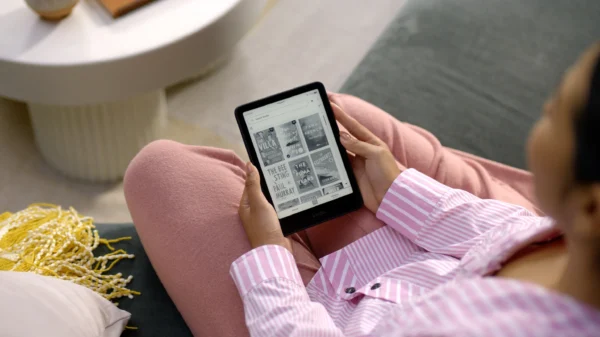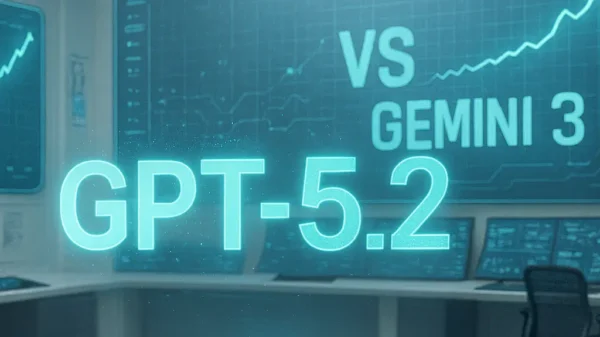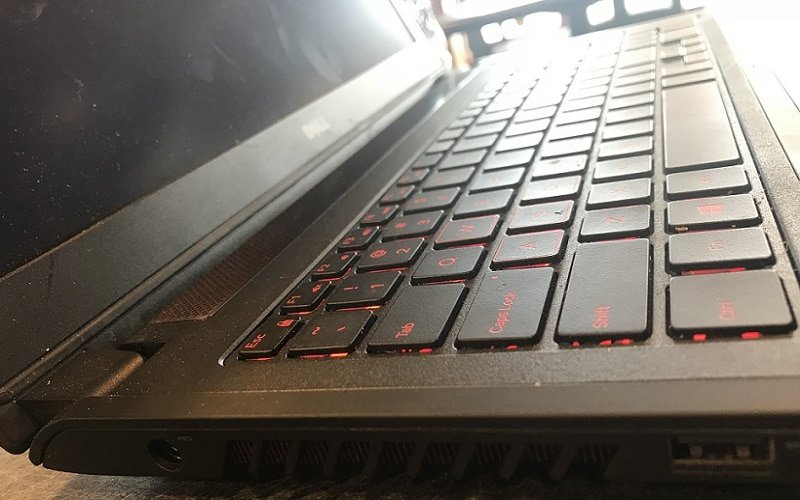Summary:
A solid gaming / performance option for the ~$500 price tag. Capable of doing most things without too much of an issue, so long as one of those things isn’t surviving on battery for a long time. Minimal design flourishes aid its viability in a work environment, but don’t expect to be blasting your way through Doom (2016) on a steady framerate.
Full Review:
Dell’s Inspiron series works as a midway between the standard Dell and the infamous Alienware brand (Also owned by Dell). The Inspiron series straddles the line between a performance and a gaming laptop, and the design has followed suit with this: While Alienware’s feature thick frames and RGB keyboards, the Inspiron series has continually iterated on a more restrained, thinner approach. There’s one or two of the traditional gaming laptop flourishes on each one – the 5000 has some red mesh tilted vents over the built-in fan and a neat black/red pattern over the speakers, for example.
But the most recent frame, the Inspiron 7000, has leaned ever closer to Alienware territory: With a red/black triangle design across the entire mouth of the laptop and large, silly looking vents towards the back, designers are slowly eating away at the aesthetics that made the line so interesting. When I saw the Inspiron 7000, I knew I had to go back, and I’m glad I did – The Inspiron 5000 is almost exactly what I was looking for, at half the price of the latest model.
Bad First:
Battery life is less-than-stellar, which is a pretty damaging category to take hits on considering the device aims at being your working laptop in addition to your playing one. The drain isn’t terrible, just a few hours short of what one might expect from a $500 to $600 laptop. 7-ish hours on a full tank is workable, but the actual lifetime ends up being something closer to 6, or 5 before you hit that ‘low battery alert’ mark and start getting worried. This is running nothing more than a web browser, too; for on-the-go gaming sessions, you might want to choose games with short levels or good manual save functionality, because you probably won’t be in the field for very long.
One thing the 7000 does have over the older model is its high-end internal components that let you run the newest of the new for, as I said above, twice the price. The 5000 does the job for most 3D indie titles and every pixel-bit 2D thing you can lay your eyes on, but starts chugging hard when we turn to the AAA department. By lowering all the settings to minimum and the resolution to 720p, I was able to bring Doom (2016) to a playable framerate – most of the time. Its less than optimal, but these limitations actually synergize really well with the game’s lesser battery life, as smaller titles tend to encourage shorter sessions.
And Now The Good:
As far as I’m concerned, the 5000 represents the perfect point that the Inspiron line has been trying to hit since its invention. At ~$500 – $600 (Depending on whether you want a GeForce or AMD Card) its the best dual-function laptop I’ve seen, or heard about, for the asking price. A solid work laptop that’s built to last might run at around three to four hundred, but the extra power offered by the Inspiron isn’t just for gaming; If your job requires you to be able to push through any kind of intensive CAD software or Photoshop renders, performance systems become all but a necessity. The Inspiron 5000 sits right on top of that line, and the gaming functionality is just icing on the cake.
You’ll also blow away your gaming brethren with how quiet and sleek your system is compared to theirs. This isn’t the backpack-buster of hyper-grade portable gaming; It’s an entertainment device in stealth mode, with just enough detail to show its true nature to fellow gamers but not enough to broadcast it down the hallway. Heat expulsion is good too. I’ve never had an issue with this device holding in – or putting out – a problematic level of thermal readings.
Better Than The 7000?
In my opinion, absolutely. The 7000 eeks too far into Alienware territory, making bids to run the top AAA 3D titles at workable framerates and peppering its sleek design with a tad too many vents and gadgets. Its main purchase point is its ability to run these AAA games, but the thing about AAA games is that they keep getting better and better as the years go on. The thing about gaming laptops is that their parts are very difficult (sometimes impossible) to replace, while a full desktop can do that easily. As it stands, the 7000 is hitting 60-ish benchmarks on games that came out 1 to 3 years ago, like Doom and Titanfall 2, according to its official webpages. If you’re buying a laptop to run high-budget titles at good framerates, just go for the Alienware. In a year or two, AAA titles will have aged out of your 7000’s power, and you’ll find yourself spending more and more time with upcoming indie titles the 5000 can already run.
Past the 5000, the Inspiron series seems to have misplaced its identity. Until it takes a step back to evaluate itself, the 5000 will remain my top pick for a budget work / gaming fusion.
Featured Image Via Me (I took this photo… Do I need to mention it here?)

















































